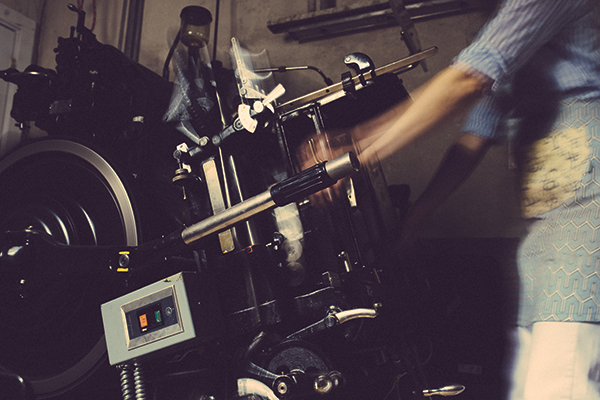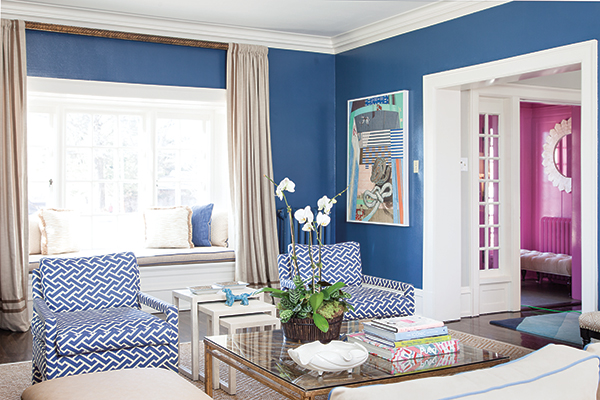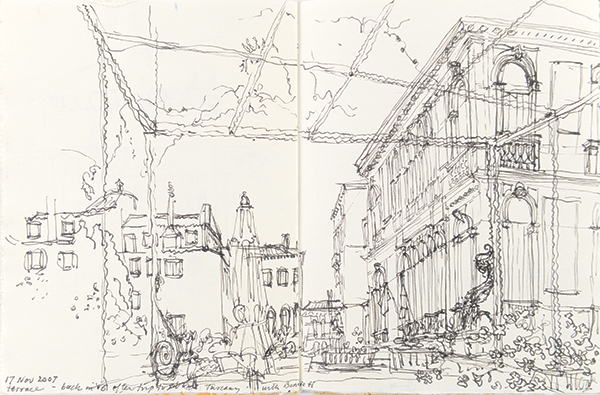
Written by Vicki L. Ingham
Photos and art courtesy of Amy Worthen
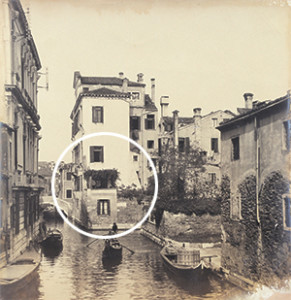
It takes vision, commitment and a sense of adventure to look at a vine-covered, bricked-up, abandoned building and see it as your future home. When the building is an 800-year-old palazzo overlooking two canals in Venice, something else kicks in as well: the desire to touch history and become part of its story.
That’s what happened when Amy and Tom Worthen of Des Moines found, renovated and settled into an apartment in this northern Italian city, transforming a crumbling property into a comfortable—and artistically and historically significant—second home.
Undertaking such a daunting project was something for which the Worthens were well-prepared. Amy, a printmaker and the curator of prints and drawings at the Des Moines Art Center, studied in Italy during college and is fluent in the language. Tom, who also speaks Italian, is a retired professor of art history at Drake University, where he specialized in the Italian Renaissance. During the 1990s, the Worthens often traveled to Italy to teach, pursue scholarly research and oversee a Drake study-abroad program in Florence. Gradually, the couple made Venetian friends, and by 2000, they had begun thinking about buying a place of their own. “We had been renting for years, so we already had a life there,” Amy says.

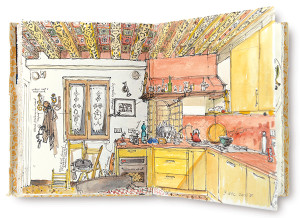
Restored painted beams and white maple cabinetry make for an inviting kitchen. Sketch by Amy Worthen.
The Search
The Worthens embarked on a search, and after looking at about 40 properties, realized that anything they bought would have to be restored. So when they answered an ad for the mansarda, or attic level, of the Palazzo Talenti, they were prepared to look beyond the bricked-up windows and crumbling stucco.
The decaying building had been empty for about 20 years and was chopped up into small rooms filled with debris. The mansarda didn’t meet their needs, but the terrace level was promising and had the bonus of an outdoor space overlooking two canals and a bridge. The palazzo was a certified historic property dating back to at least the 12th or 13th century, as proved by Byzantine-era windows discovered in the foundations. It appears as a two-story building on a map of Venice printed in 1500. Sometime after the 1500s, owners added two additional stories plus the mansarda. In Italy, “palazzo” can refer to any grand city dwelling, not just an aristocratic palace. The name Talenti isn’t a noble Venetian name, Amy says, but rather Florentine, and has a coat of arms associated with it.
The Worthens learned that investors had bought the entire palazzo and were planning to renovate it, divide it into apartments and sell the individual units. This would be an advantage for the Worthens because the investors would handle the tortuous process of securing building permits and approvals, overseeing demolition and reconstruction, and ensuring that everything met European codes.
Exciting Discovery
From the time of the Worthens’ first offer (rejected) to their final offer (accepted), a year had passed. Over the next 2 1/2 years, workers gutted the building and installed steel beams to support the ceilings and upper floors. In the process, they made an exciting discovery: Above the plaster ceilings were original timber-beamed ceilings with traces of painted decoration dating from the 15th, 16th and 17th centuries. Several layers of paint had to be painstakingly removed to reveal the designs: cassetoni, or little squares, with rosettes framed by braided molding on the ceiling, and flowers and masks on the beams.
In what became the kitchen, workers uncovered two cycles of decoration. Shells and flowers on a red background dated from the 1400s, while in the 1500s, the beams were repainted with masks and vases in black and white. In the living area, 17th-century owners reinterpreted the Renaissance masks and vases in a more painterly style with individualized flourishes—one face even sported a pair of spectacles.
The discovery required a visit from the Venetian superintendent of fine arts, who told the Worthens they’d need to clean and restore all three sides of the beams as well as the ceiling between. The couple hired two restoration experts, but Amy contributed as well. There were 30 pieces of molding missing from the cassetoni, so Amy made a stencil and used earth pigments mixed with fish glue to paint new strips of molding with the braided pattern. The carpenters then cut the strips to the lengths needed to fill in the missing pieces.
In addition to the painted beams, the Worthens had to restore the thick terrazzo veneziano floors, which are composed of tiny stones held in a binder that contains oil. This gives the floors sufficient flexibility to withstand the instability of foundations sunk deep in the mud of the lagoon. New drywall hangs on metal lath, leaving a space between the historic exterior and the new interior for plumbing and electrical lines.
The Worthens used white maple cabinetry to divide the apartment into a living room, bedroom, kitchen-dining room and baths. “I think the blond wood was the influence of the Saarinen woodwork at the Art Center,” Amy says. A glass ceiling in the bathroom provides privacy but leaves the historic ceiling visible.
Wonderful Wisteria
Once the apartment was livable, the next project was to persuade the government to let Tom and Amy restore the pergola over the terrace. “The law in Venice regarding restoration is you can only do what was already there, so you have to document how it looked originally before you can do anything to the exterior,” Amy explains. Fortunately, their palazzo had been considered sufficiently picturesque to be captured in old photos and postcards (see image, page 138). They began collecting vintage images showing the terrace with a pergola and eventually won permission to reintroduce it.
Amy had envisioned the pergola covered by wisteria. “One day, the director of works showed up with a plant, just a stick,” Amy says. “He had no idea what kind it was.” It proved to be a luxuriant Wisteria japonica that produces long chains of lavender flowers for three weeks every April. “I’m obsessed by the wisteria,” she says, and has hundreds of photos to prove it. “I have to be there in April to see it.”
The Worthens are the only non-Italians in the palazzo, which has 10 units, but they have become active members of the community. Amy is a member of the Cittadini di San Giacomo, a neighborhood group that handles problems such as garbage collection and speeding in the canals. She understands and can read the Venetian dialect “and can amuse people with it, but it doesn’t sound right” when she tries to speak it, she says. Tom’s expertise is in 16th- and 17th-century Italian, but he can express himself comfortably in the modern tongue too.
That facility with the language was one reason they felt prepared to tackle the challenge in the first place. “We had plenty of friends too,” says Amy. “I felt confident I was well-supported. You have this dream that’s really scary, and then giving yourself permission to fulfill it is scary—and thrilling too. We knew this was a very special property and there weren’t many like it.” The chance to be a part of rescuing it meant “being able to connect and make ourselves part of this history.”
Over the years, many Iowans have visited Amy and Tom Worthen in Venice and enjoyed the view from their terrace, including the following (click on the photo to see the names):






















